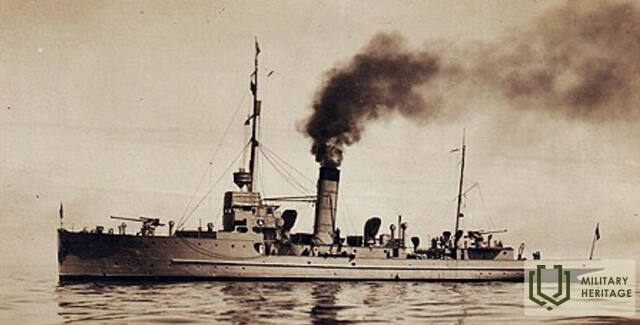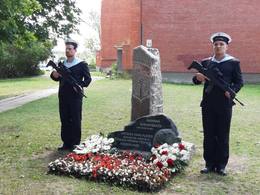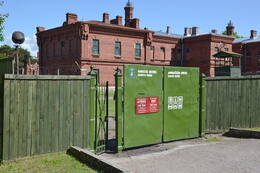Latvijos karinės jūrų pajėgos
I WW1, I Nepriklausomybės karai, Baltijos šalių nepriklausomybė, II Antrasis pasaulinis karas, IV Sovietų okupacija, Atkurta Nepriklausomybė
Oficiali Latvijos karinio jūrų laivyno įkūrimo data buvo 1919 m. rugpjūčio 10 d., kai Latvijos ginkluotųjų pajėgų vyriausiojo vado generolo D. Sīmansono štabe buvo įkurtas Karinio jūrų laivyno divizionas, kuriam priklausė anksčiau įkurta jūreivių kuopa ir Minų paieškos partija. Laisvės kovų metu (1918–1920 m.) ypač išryškėjo poreikis sukurti savo karinį jūrų laivyną naujajai Latvijos valstybei. Kare dalyvavo privatūs prekybiniai laivai, kateriai, garlaiviai ir vilkikai. Karinio jūrų laivyno divizionas reikšmingai prisidėjo prie Bermontiados. Dauguvos kairiajame krante, netoli Daugavgryvos tvirtovės, jis desantavo 9-ąjį Rėzeknės pėstininkų pulką, dalyvavo mūšiuose prie Volerių dvaro, Vārnukrogo ir Šmito cemento gamyklos, dalyvavo užimant Jelgavą ir desantavo diversijų dalinį netoli Ragaciemo. 1921 m. birželio 12 d. buvo nuleistas pirmasis Latvijos karinio jūrų laivyno laivas „VIRSAITIS“, kuris vėliau tarnavo kaip flagmanas. Vadovaujantis 1920 m. spalio mėn. Tautų Sąjungos nuostatomis, Latvijai buvo leista įsteigti ir išlaikyti karinį jūrų laivyną. 1924 m. Respublikos Prezidento įsakymu atskiri laivyno daliniai buvo pervadinti į Pakrančių gynybos eskadrilę, o jos vadu paskirtas kapitonas A. Keizerlingas. 1922 m. gruodžio 1 d. Aviacijos divizione buvo įkurtas Karinio jūrų laivyno aviacijos skyrius, tačiau 1923 m. jis buvo atskirtas ir pavaldus Generalinio štabo specialiųjų užduočių karininkui jūrų reikalams, o vėliau Pakrančių gynybos eskadrilės vadui. 1926 m. gegužės 1 d. buvo įkurtas atskiras Karinio jūrų laivyno aviacijos skyrius.
Karinis jūrų laivynas buvo brangiausias Latvijos ginkluotųjų pajėgų dalinys, tačiau jis turėjo ne tik nacionalinės gynybos, bet ir tarptautinį prestižą. 1938 m. gynybos eskadrilė buvo pervadinta į Latvijos karinį jūrų laivyną, o liepos 15 d. karo ministras generolas J. Balodis iškilmingai įteikė jam karinio jūrų laivyno vėliavą su šūkiu: „Mus vienija šventas Latvijos vardas“. Latvijos karinis jūrų laivynas pradėjo formuotis Išvadavimo karo metu, kai tapo aišku, kad šaliai, turinčiai 496 kilometrų ilgio pakrantės sieną, reikia pajėgų jai ginti. Pagrindinės karinio jūrų laivyno užduotys buvo pakrantės apsauga minomis, mobilia pakrantės artilerija, povandeniniais laivais, lėktuvais, torpedomis ir mažais greitaeigiais karo laivais, ginkluotais lengvaisiais greitašaudėmis patrankomis. Latvijos karinio jūrų laivyno nuosmukis prasidėjo 1940 m. vasarą, kai Latvija buvo priverstinai įjungta į SSRS. Dauguma Latvijos karinio jūrų laivyno laivų ir povandeninių laivų buvo sunaikinti arba prarasti Antrojo pasaulinio karo metu. Latvijos karinis jūrų laivynas buvo atkurtas 1992 m., atkūrus Latvijos nepriklausomybę. 1992 m. balandžio 11 d. ant pirmojo atnaujinto laivyno karo laivo „Sams“ įvyko iškilminga vėliavos pakėlimo ceremonija. Ši data laikoma Latvijos karinio jūrų laivyno atgimimo diena.
Daugiau informacijos šaltinių
https://www.mil.lv/lv/vienibas/juras-speki/kara-flotes-vesture (žiūrėta 2021-10-27)
https://lv.wikipedia.org/wiki/Kara_flote (žiūrėta 2021-10-27)
Susijusios vietos
Paminklas Kaizerlingsui, Latvijos karinio jūrų laivyno įkūrėjui ir vadui
Archibaldas Peteris Teofilius fon Keizerlingas, dar žinomas kaip Archibaldas Keizerlingas, buvo karinio jūrų laivyno karininkas, pirmasis Latvijos Respublikos pakrantės gynybos eskadrilės vadas admirolas. Jis atliko svarbų vaidmenį kuriant Latvijos karinį jūrų laivyną.
A. Keizerlingas buvo kilęs iš senos vokiečių didikų šeimos, gimęs 1882 m. lapkričio 18 d. Augustės dvare, Gruobinios parapijoje.
1895 m. jis įstojo į Rusijos carinio laivyno Sankt Peterburgo jūrų kadetų korpusą, kurį baigė 1901 m., gavęs jaunesniojo karininko laipsnį. Keizerlingas tarnavo 13-ajame laivyne Rusijos Tolimuosiuose Rytuose ir dalyvavo Rusijos-Japonijos kare. 1905 m. gegužę pateko į japonų nelaisvę, bet paleistas buvo paaukštintas iki leitenanto.
1906 m. Keizerlingas buvo vyresnysis karininkas minų kreiseryje. Nuo 1907 iki 1908 m. jis lankė Liepojos povandeninių laivų kursus Liepojoje. Baigęs kursus, jis vėl išvyko į Vladivostoką, kur tarnavo Rusijos Ramiojo vandenyno laivyne, o nuo 1908 iki 1912 m. buvo povandeninio laivo „feldmaršalas grafas Šeremetjevas“ kapitonas. 1911 m. jam buvo suteiktas pirmojo leitenanto laipsnis.
Perkėlęs į Baltijos laivyną, buvo eskadrilės minų tralerio kapitonas, dalyvavo Pirmajame pasauliniame kare, kurio pabaigoje jau buvo 1-ojo rango kapitonas.
1918 m. liepą jis išėjo į pensiją iš tarnybos. 1919 m. pradžioje A. Keizerlingas įstojo į Baltijos landesverą, kur tarnavo kavalerijos eskadrilės vadu, turėdamas štabo seržanto laipsnį.
1920 m. balandžio 1 d., kai faktiškai prasidėjo Latvijos karinio jūrų laivyno formavimas, jis buvo paskirtas Sausumos pajėgų štabo viršininko specialiųjų užduočių karininku. 1921 m. Keizerlingui buvo suteiktas jūrų kapitono laipsnis. 1924 m. birželio 27 d. buvo įkurta Latvijos pakrantės gynybos eskadrilė, kurios vadu buvo paskirtas A. Keizerlingas, o 1927 m. – admirolo laipsnis.












